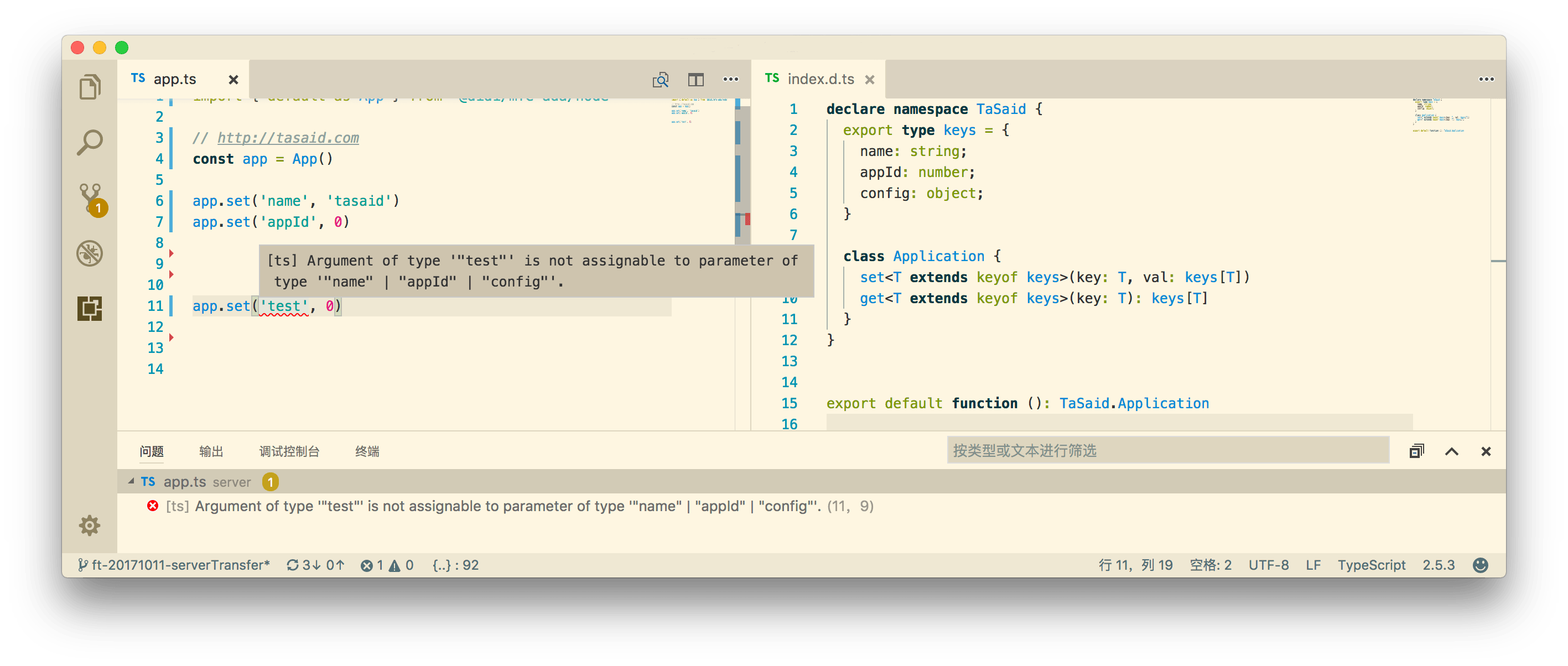JavaScript 和 TypeScript 交叉口 —— 类型定义文件(*.d.ts)
在 《从 JavaScript 到 TypeScript 系列》 文章我们已经学习了 TypeScript 相关的知识。
TypeScript 的核心在于静态类型,我们在编写 TS 的时候会定义很多的类型,但是主流的库都是 JavaScript 编写的,并不支持类型系统。那么如何让这些第三方库也可以进行类型推导呢?
这篇文章我们来讲解 JavaScript 和 TypeScript 的静态类型交叉口 —— 类型定义文件。
这篇文章首发于我的个人博客 《听说》。
前端开发 QQ 群:377786580
类型定义文件
在 TypeScript 中,我们可以很简单的,在代码编写中定义类型:
interface IBaseModel {
say(keys: string[] | null): object
}
class User implements IBaseModel {
name: string
constructor (name: string) {
this.name = name
}
}
但是主流的库都是 JavaScript 编写的,TypeScript 身为 JavaScript 的超集,自然需要考虑到如何让 JS 库也能定义静态类型。
TypeScript 经过了一系列的摸索,先后提出了 tsd(已废弃)、typings(已废弃),最终在 TypeScript 2.0 的时候重新整理了类型定义,提出了 DefinitelyTyped。
DefinitelyTyped 就是让你把 "类型定义文件(*.d.ts)",发布到 npm 中,配合编辑器(或插件),就能够检测到 JS 库中的静态类型。
类型定义文件的以 .d.ts 结尾,里面主要用来定义类型。
例如这是 jQuery 的类型定义文件 中一段代码(为了方便理解做了一些改动)
// 定义 jQuery 需要用到的类型命名空间
declare namespace JQuery {
// 定义基本使用的类型
type Selector = string;
type TypeOrArray<T> = T | T[];
type htmlString = string;
}
// 定义 jQuery 接口,jquery 是一个 包含 Element 的集合
interface JQuery<TElement extends Node = HTMLElement> extends Iterable<TElement> {
length: number;
eq(index: number): this;
// 重载
add(selector: JQuery.Selector, context: Element): this;
add(selector: JQuery.Selector | JQuery.TypeOrArray<Element> | JQuery.htmlString | JQuery): this;
children(selector?: JQuery.Selector): this;
css(propertyName: string): string;
html(): string;
}
// 对模块 jquery 输出接口
declare module 'jquery' {
// module 中要使用 export = 而不是 export default
export = jQuery;
}
类型定义
*.d.ts 编写起来非常简单,经过 TypeScript 良好的静态类型系统洗礼过后,语法学习成本非常低。
我们可以使用 type 用来定义类型变量:
// 基本类型
type UserName = string
// 类型赋值
type WebSite = string
type Tsaid = WebSite
可以看到 type 其实可以定义各种格式的类型,也可以和其他类型进行组合。
// 对象
type User = {
name: string;
age: number;
website: WebSite;
}
// 方法
type say = (age: number) => string
// 类
class TaSaid {
website: string;
say: (age: number) => string;
}
当然,我们也可以使用 interface 定义我们的复杂类型,在 TS 中我们也可以直接定义 interface:
interface Application {
init(): void
get(key: string): object
}
interface 和 type(或者说 class) 很像。
但是 type 的含义是定义自定义类型,当 TS 提供给你的基础类型都不满足的时候,可以使用 type 自由组合出你的新类型,而 interface 应该是对外输出的接口。
type 不可以被继承,但 interface 可以:
interface BaseApplication {
appId: number
}
export interface Application extends BaseApplication {
init(): void
get(key: string): object
}
declare
declare 可以创建 *.d.ts 文件中的变量,declare 只能作用域最外层:
declare var foo: number;
declare function greet(greeting: string): void;
declare namespace tasaid {
// 这里不能 declare
interface blog {
website: 'http://tasaid.com'
}
}
基本上顶层的定义都需要使用 declare, class 也是:
declare class User {
name: string
}
namespace
为防止类型重复,使用 namespace 用于划分区域块,分离重复的类型,顶层的 namespace 需要 declare 输出到外部环境,子命名空间不需要 declare。
// 命名空间
declare namespace Models {
type A = number
// 子命名空间
namespace Config {
type A = object
type B = string
}
}
type C = Models.Config.A
组合定义
上面我们只演示了一些简单的类型组合,生产环境中会包含许多复杂的类型定义,这时候我们就需要各种组合出强大的类型定义:
动态属性
有些类型的属性名是动态而未知的,例如:
{
'10086': {
name: '中国移动',
website: 'http://www.10086.cn',
},
'10010': {
name: '中国联通',
website: 'http://www.10010.com',
},
'10000': {
name: '中国电信',
website: 'http://www.189.cn'
}
}
我们可以使用动态属性名来定义类型:
interface ChinaMobile {
name: string;
website: string;
}
interface ChinaMobileList {
// 动态属性
[phone: string]: ChinaMobile
}
类型遍历
当你已知某个类型范围的时候,可以使用 in 和 keyof 来遍历类型,例如上面的 ChinaMobile 例子,我们可以使用 in 来约束属性名必须为三家运营商之一:
type ChinaMobilePhones = '10086' | '10010' | '10000'
interface ChinaMobile {
name: string;
website: string;
}
// 只能 type 使用, interface 无法使用
type ChinaMobileList = {
// 遍历属性
[phone in ChinaMobilePhones]: ChinaMobile
}
我们也可以用 keyof 来约定方法的参数
export type keys = {
name: string;
appId: number;
config: object;
}
class Application {
// 参数和值约束范围
set<T extends keyof keys>(key: T, val: keys[T])
get<T extends keyof keys>(key: T): keys[T]
}

集成发布
有两种主要方式用来发布类型定义文件到 npm:
- 与你的 npm 包捆绑在一起(内置类型定义文件)
- 发布到 npm 上的 @types organization
前者,安装完了包之后会自动检测并识别类型定义文件。
后者,则需要通过 npm i @types/xxxx 安装,这就是我们前面所说的 DefinitelyTyped ,用于扩展 JS 库的类型声明。
内置类型定义文件
内置类型定义就是把你的类型定义文件和 npm 包一起发布,一般来说,类型定义文件都放在包根目录的 types 目录里,例如 vue:
如果你的包有一个主 .js 文件,需要在 package.json 里指定主类型定义文件。
设置 types 或 typeings 属性指向捆绑在一起的类型定义文件。 例如包目录如下:
├── lib
│ ├── main.js
│ └── main.d.ts # 类型定义文件
└── package.json
// pageage.json
{
"name": "demo",
"author": "demo project",
"version": "1.0.0",
"main": "./lib/main.js",
// 定义主类型定义文件
"types": "./lib/main.d.ts"
}
如果主类型定义文件名是 index.d.ts 并且位置在包的根目录里,就不需要使用 types 属性指定了。
├── lib
│ └── main.js
├── index.d.ts # 类型定义文件
└── package.json
如果你发的包中,package.json 中使用了 files 字段的话(npm 会根据 files 配置的规则决定发布哪些文件),则需要手动把类型定义文件加入:
// pageage.json
{
"files": [
"index.js",
"*.d.ts"
]
}
如果只发二级目录的话,把类型定义文件放到对应的二级目录下即可:
import { default as App } from 'demo/app'
发布到 @types organizatio
发布到 @types organizatio 的包表示源包没有包含类型定义文件,第三方/或原作者定义好类型定义文件之后,发布到 @types 中。例如 @types/express。
根据 DefinitelyTyped 的规则,和编辑器(和插件) 自动检测静态类型。
@types 下面的包是从 DefinitelyTyped 里自动发布的,通过 types-publisher 工具。
如果想让你的包发布为 @types 包,需要提交一个 pull request 到 https://github.com/DefinitelyTyped/DefinitelyTyped。
在这里查看详细信息 contribution guidelines page。
如果你正在使用 TypeScript,而使用了一些 JS 包并没有对应的类型定义文件,可以编写一份然后提交到 @types。
赠人玫瑰,手留余香。
发布到 @types organizatio 的包可以通过 TypeSearch 搜索检索,使用 npm install --save-dev @types/xxxx 安装:

更多细节请参阅 DefinitelyTyped。
其他
module
通常来说,如果这份类型定义文件是 JS 库自带的,那么我们可以直接导出模块:
interface User {}
export = User
而如果这份类型定义文件不是 JS 库自带的,而是第三方的,则需要使用 module 进行关联。
例如 jquery 发布的 npm 包中不包含 *.d.ts 类型定义文件,jquery 的类型定义文件发布在了 @types/jquery,所以类型定义文件中导出类型的时候,需要关联模块 jquery,意思就是我专门针对这个包做的类型定义:
interface jQuery {}
declare module 'jquery' {
// module 中要使用 export = 而不是 export default
export = jQuery;
}
从而解决了一些主流的 JS 库发布的 npm 包中没有类型定义文件,但是我们可以用第三方类型定义文件为这些库补充类型。
风格
经过一系列探索,个人比较推荐下面的编写风格,先看目录:
types
├── application.d.ts
├── config.d.ts
├── index.d.ts # 入口模块
└── user.d.ts

入口模块主要做这些事情:
- 定义命名空间
- 导出和聚合子模块
主出口文件 index.d.ts:
import * as UserModel from './user'
import * as AppModel from './application'
import * as ConfigModel from './config'
declare namespace Models {
export type User = UserModel.User;
export type Application = AppModel.Application;
// 利用 as 抹平争议性变量名
export type Config = ConfigModel.Config;
}
子模块无需定义命名空间,这样外部环境 (types 文件夹之外) 则无法获取子模块类型,达到了类型封闭的效果:
export interface User {
name: string;
age: number
}


 TypeScript 的核心在于静态类型。但是主流的库都是 JavaScript 编写的,那么如何让这些第三方库也可以类型呢?
这篇文章我们来讲解 JavaScript 和 TypeScript 的静态类型交叉口 —— 类型定义文件。
TypeScript 的核心在于静态类型。但是主流的库都是 JavaScript 编写的,那么如何让这些第三方库也可以类型呢?
这篇文章我们来讲解 JavaScript 和 TypeScript 的静态类型交叉口 —— 类型定义文件。





【推荐】国内首个AI IDE,深度理解中文开发场景,立即下载体验Trae
【推荐】编程新体验,更懂你的AI,立即体验豆包MarsCode编程助手
【推荐】抖音旗下AI助手豆包,你的智能百科全书,全免费不限次数
【推荐】轻量又高性能的 SSH 工具 IShell:AI 加持,快人一步
· 从 HTTP 原因短语缺失研究 HTTP/2 和 HTTP/3 的设计差异
· AI与.NET技术实操系列:向量存储与相似性搜索在 .NET 中的实现
· 基于Microsoft.Extensions.AI核心库实现RAG应用
· Linux系列:如何用heaptrack跟踪.NET程序的非托管内存泄露
· 开发者必知的日志记录最佳实践
· TypeScript + Deepseek 打造卜卦网站:技术与玄学的结合
· Manus的开源复刻OpenManus初探
· 写一个简单的SQL生成工具
· AI 智能体引爆开源社区「GitHub 热点速览」
· C#/.NET/.NET Core技术前沿周刊 | 第 29 期(2025年3.1-3.9)